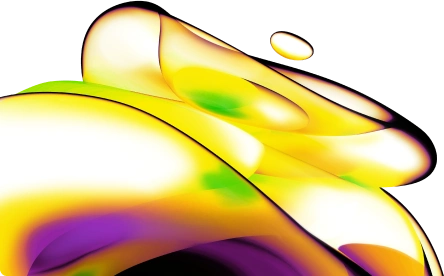

AlphaLISA SureFire Ultra Human and Mouse Total BTK Detection Kit, 500 Assay Points
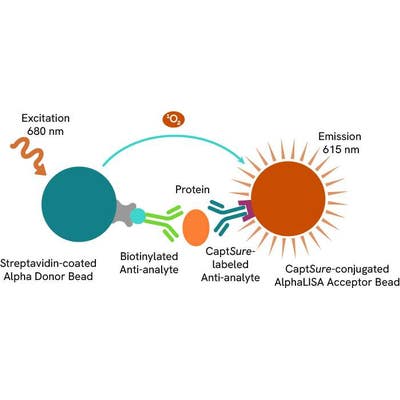

 View All
View All
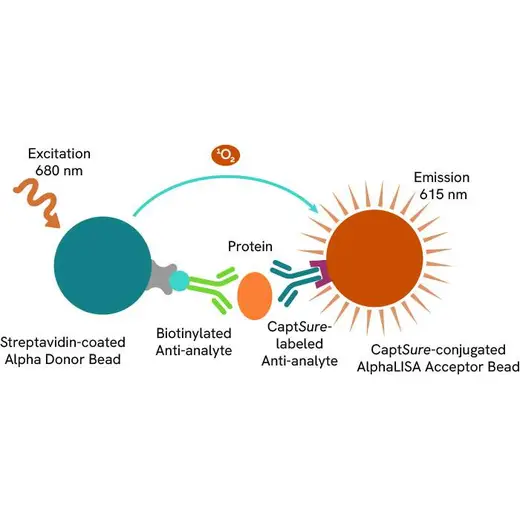









| Feature | Specification |
|---|---|
| Application | Cell Signaling |
| Sample Volume | 10 µL |















Product information
Overview
Bruton's tyrosine kinase (BTK) is a non-receptor tyrosine kinase that plays a critical role in B-cell receptor (BCR) signaling, which is essential for B-cell development, differentiation, and survival. BTK is involved in the activation of downstream signaling pathways including NF-κB, MAPK, and PLCγ2, and is a key regulator of immune responses. Dysregulation or mutation of BTK is associated with immunodeficiencies such as X-linked agammaglobulinemia (XLA) and various B-cell malignancies. BTK has emerged as a prominent therapeutic target, with several BTK inhibitors approved or in development for the treatment of hematologic cancers and autoimmune diseases.
The AlphaLISA SureFire Ultra Human and Mouse Total BTK Detection Kit is a sandwich immunoassay for the quantitative detection of total BTK in cellular lysates, using Alpha Technology.
Formats:
- The HV (high volume) kit contains reagents to run 100 wells in 96-well format, using a 60 µL reaction volume.
- The 500-point kit contains enough reagents to run 500 wells in 384-well format, using a 20 µL reaction volume.
- The 10,000-point kit contains enough reagents to run 10,000 wells in 384-well format, using a 20 µL reaction volume.
- The 50,000-point kit contains enough reagents to run 50,000 wells in 384-well format, using a 20 µL reaction volume.
In the AlphaLISA™ SureFire® Ultra™ assay, Donor beads are coated with streptavidin to capture one of the antibodies, which is biotinylated. Acceptor beads are coated with a proprietary CaptSure™ agent that immobilizes the other antibody, labeled with a CaptSure™ tag. In the presence of target protein, the two antibodies bring the Donor and Acceptor beads close together, generating signal. The amount of light emission is directly proportional to the amount of protein present in the sample.
AlphaLISA™ SureFire® Ultra™ kits are compatible with:
- Cell and tissue lysates
- Antibody modulators
- Biotherapeutic antibodies
Alpha SureFire® kits can be used for:
- Cellular kinase assays
- Receptor activation studies
- Screening
How it works
Total-AlphaLISA SureFire Ultra assay principle
The Total-AlphaLISA SureFire Ultra assay measures the expression level of a protein target in a cell lysate.
The Total-AlphaLISA SureFire Ultra assay uses two antibodies which recognize two different distal epitopes on the targeted protein. AlphaLISA assays require two bead types: Acceptor and Donor beads. Acceptor beads are coated with a proprietary CaptSure™ agent to specifically immobilize the assay specific antibody, labeled with a CaptSure tag. Donor beads are coated with streptavidin to capture one of the detection antibodies, which is biotinylated. In the presence of targeted protein, the two antibodies bring the Donor and Acceptor beads in close proximity whereby the singlet oxygen transfers energy to excite the Acceptor bead, allowing the generation of a luminescent Alpha signal. The amount of light emission is directly proportional to the quantity of protein present in the sample.

Total-AlphaLISA SureFire Ultra two-plate assay protocol
The two-plate protocol involves culturing and treating the cells in a 96-well plate before lysis, then transferring lysates into a 384-well OptiPlate™ plate before the addition of Total-AlphaLISA SureFire Ultra detection reagents. This protocol permits the cells viability and confluence to be monitored. In addition, lysates from a single well can be used to measure multiple targets.
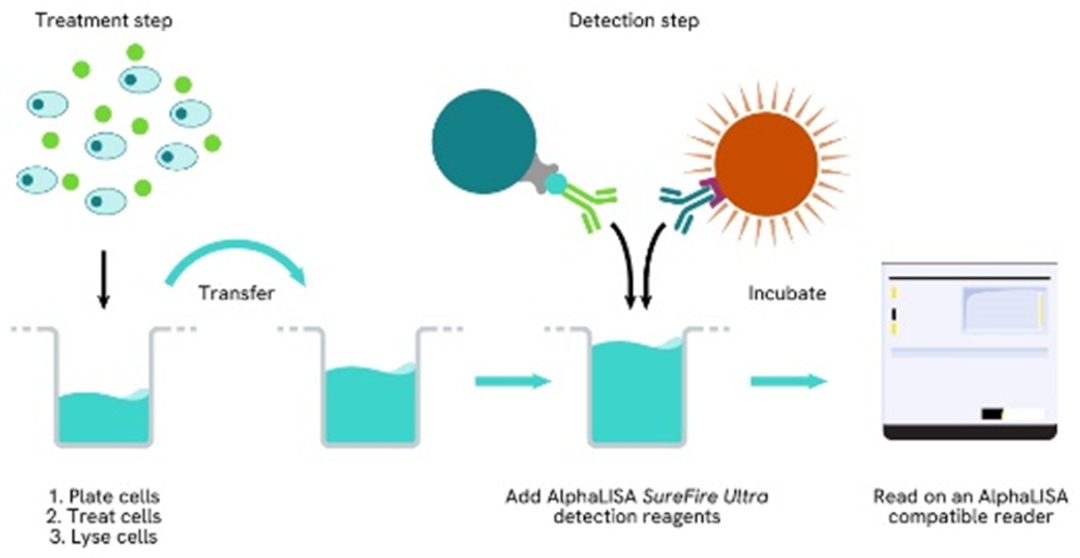
Total-AlphaLISA SureFire Ultra one-plate assay protocol
Detection of Total target protein with AlphaLISA SureFire Ultra reagents can be performed in a single plate used for culturing, treatment, and lysis. No washing steps are required. This HTS designed protocol allows for miniaturization while maintaining AlphaLISA SureFire Ultra quality.
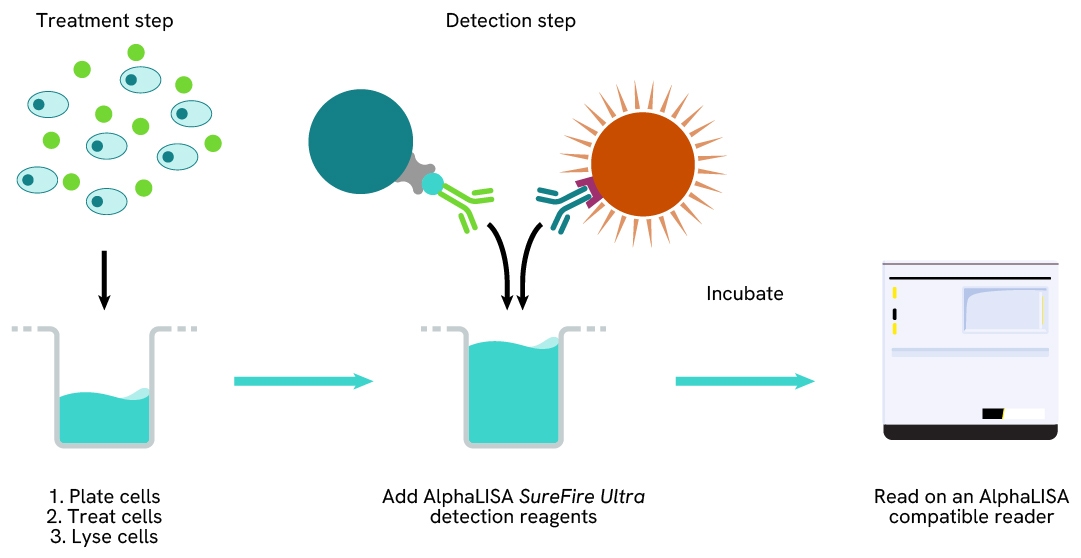
Assay validation
Induction of BTK phosphorylation in Anti-IgM treated cells
Ramos cells were washed, resuspended in HBSS + 0.1% BSA at a density of 6 x 106 cells/mL and seeded in a 96-well plate. Cells were treated with increasing concentrations of anti-IgM for 10 minutes.
After treatment, the cells were lysed with the addition of 50 µL of 5X Lysis Buffer for 10 minutes at RT with shaking (350 rpm). BTK Phospho (Y223, Y551) and Total levels were evaluated using respective AlphaLISA SureFire Ultra assays. For the detection step, 10 µL of cell lysate (approximately 24,000 cells) was transferred into a 384-well white OptiPlate, followed by 5 µL of Acceptor mix and incubated for 1 hour at RT. Finally, 5 µL of Donor mix was then added to each well and incubated for 1 hour at RT in the dark. The plate was read on an Envision using standard AlphaLISA settings.
As expected, anti-IgM triggered an increase in the levels of Phospho (Y223, Y551) BTK whilst Total levels remained unchanged.
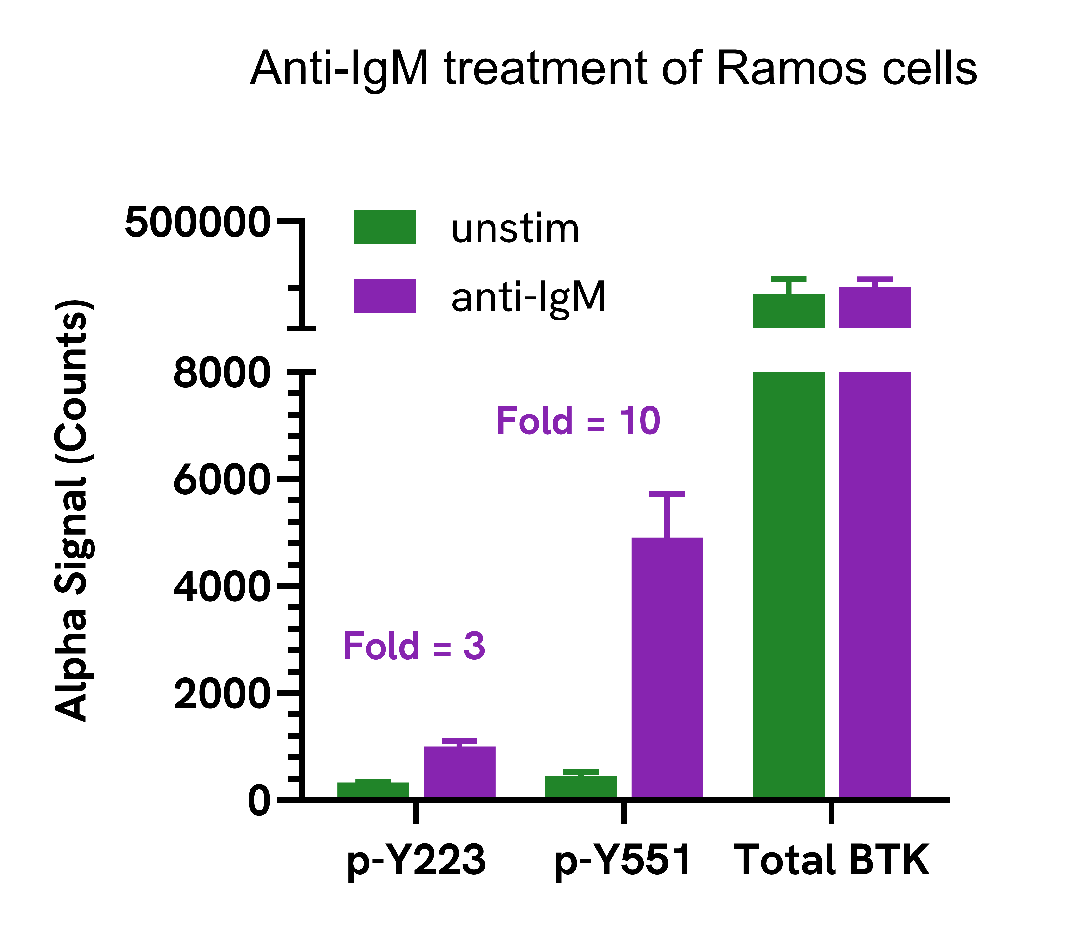
Validation of Total BTK assay in Pervanadate treated cells
U937 cells were washed, resuspended in HBSS + 0.1% BSA at a density of 200,000 cells/well and seeded in a 96-well plate. Cells were treated with increasing concentrations of Pervanadate for 30 minutes.
After treatment, the cells were lysed with the addition of 50 µL of 5X Lysis Buffer for 10 minutes at RT with shaking (350 rpm). BTK Phospho (Y223, Y551) and Total levels were evaluated using respective AlphaLISA SureFire Ultra assays. For the detection step, 10 µL of cell lysate (approximately 8,000 cells) was transferred into a 384-well white OptiPlate, followed by 5 µL of Acceptor mix and incubated for 1 hour at RT. Finally, 5 µL of Donor mix was then added to each well and incubated for 1 hour at RT in the dark. The plate was read on an Envision using standard AlphaLISA settings.
As expected, Pervanadate triggered a dose-dependent increase in the levels of Phospho (Y223, Y551) BTK whilst Total levels remained unchanged.
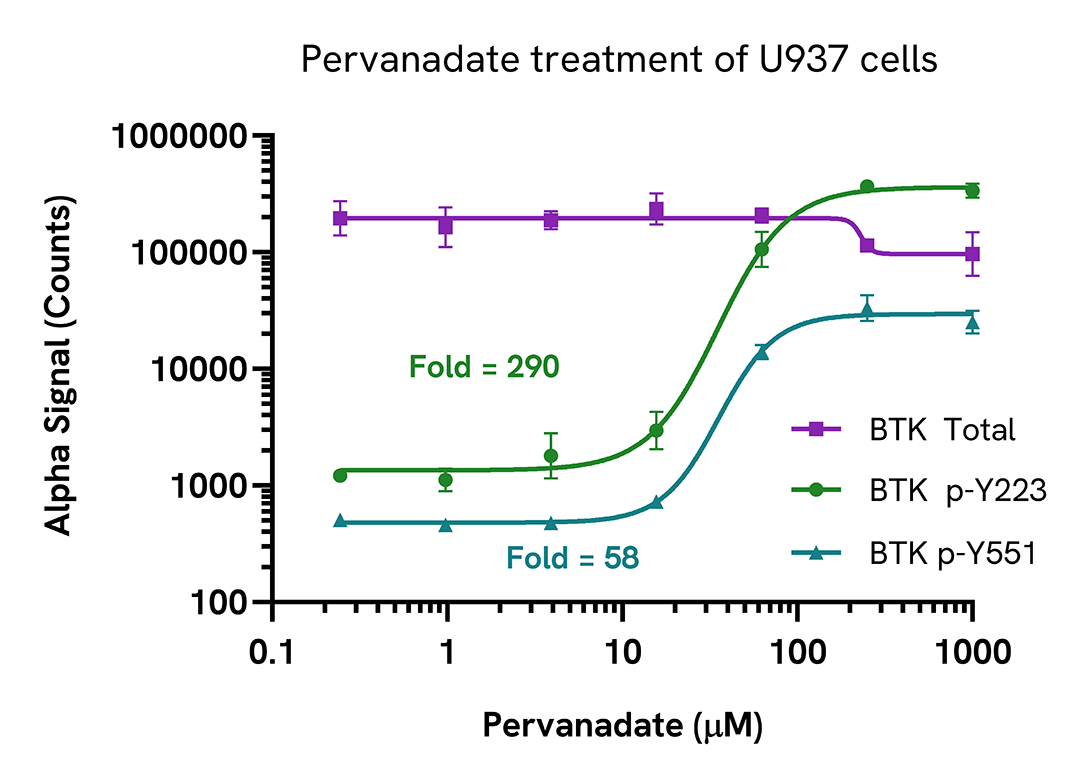
Specific degradation of BTK using NX-5948 PROTAC
Ramos cells were seeded in a 96-well plate (100,000 cells/well) in complete medium. The cells were treated for 2 hours with 6.7 µM MG132, followed by increasing concentrations of NX-5948 for 2 hours.
After treatment, the cells were lysed with 100 µL of Lysis Buffer for 10 minutes at RT with shaking (350 rpm). BTK and Cofilin levels were evaluated using respective AlphaLISA SureFire Ultra assays. For the detection step, 10 µL of cell lysate (approximately 4,000 cells) was transferred into a 384-well white OptiPlate, followed by 5 µL of Acceptor mix and incubated for 1 hour at RT. Finally, 5 µL of Donor mix was then added to each well and incubated for 1 hour at RT in the dark. The plate was read on an Envision using standard AlphaLISA settings.
As expected, NX-5948 induced a dose-dependent decrease in BTK levels. The lack of protein degradation in the presence of MG132 confirmed that the degradation was driven by the ubiquitin-proteosome system.
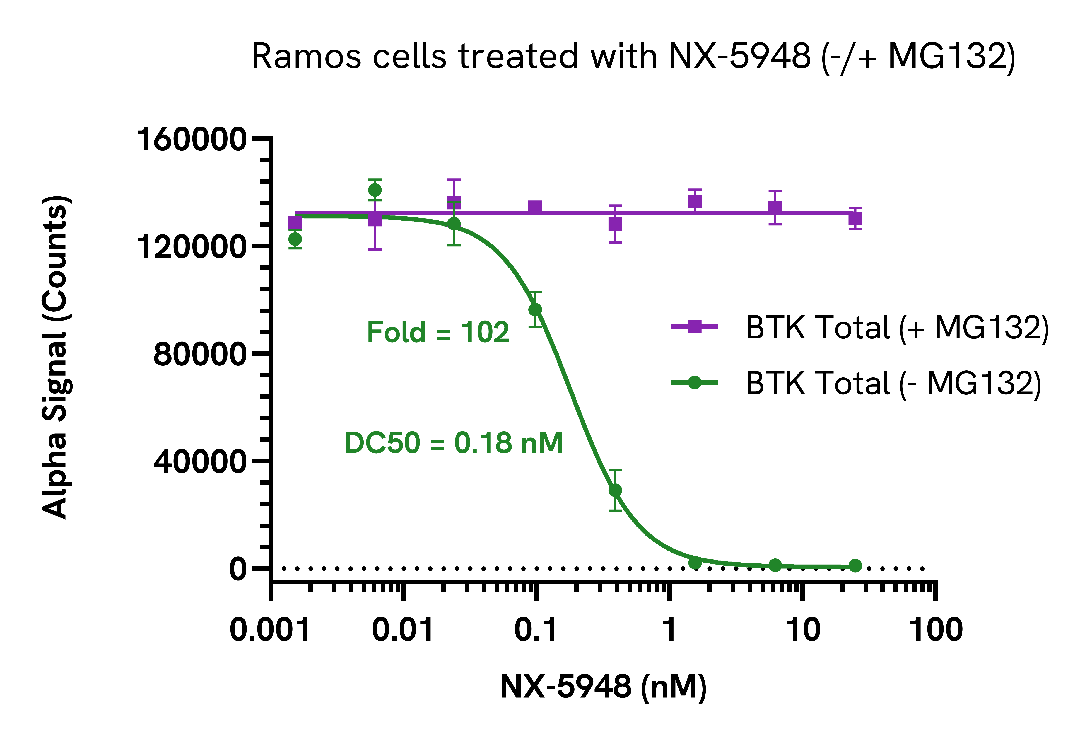
PROTAC-mediated degradation of BTK in PBMCs
PBMCs were isolated from healthy donors using Ficoll® Plaque Plus and seeded in a 96-well plate (400,000 cells/well) in complete DMEM. Cells were treated with increasing concentrations of NX-5948 for 2.5 hours.
After treatment, the cells were lysed with 100 µL of Lysis Buffer for 10 minutes at RT with shaking (350 rpm). BTK and Cofilin levels were evaluated using respective AlphaLISA SureFire Ultra assays. For the detection step, 10 µL of cell lysate (approximately 40,000 cells) was transferred into a 384-well white OptiPlate, followed by 5 µL of Acceptor mix and incubated for 1 hour at RT. Finally, 5 µL of Donor mix was then added to each well and incubated for 1 hour at RT in the dark. The plate was read on an Envision using standard AlphaLISA settings.
As expected, NX-5948 triggered a dose-dependent decrease in the levels of BTK.
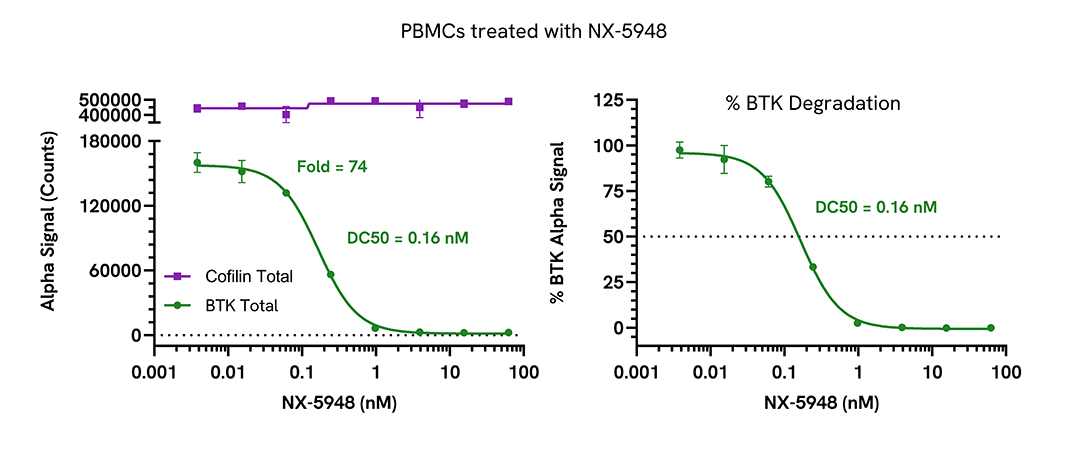
PBMCs were isolated from healthy donors using Ficoll® Plaque Plus and seeded in a 96-well plate (400,000 cells/well) in complete DMEM. Cells were treated with increasing concentrations of GBD-9 for 16 hours.
After treatment, the cells were lysed with 100 µL of Lysis Buffer for 10 minutes at RT with shaking (350 rpm). BTK and Cofilin levels were evaluated using respective AlphaLISA SureFire Ultra assays. For the detection step, 10 µL of cell lysate (approximately 40,000 cells) was transferred into a 384-well white OptiPlate, followed by 5 µL of Acceptor mix and incubated for 1 hour at RT. Finally, 5 µL of Donor mix was then added to each well and incubated for 1 hour at RT in the dark. The plate was read on an Envision using standard AlphaLISA settings.
As expected, GBD-9 triggered a dose-dependent decrease in the levels of BTK.

Optimization of PROTAC induced BTK degradation
Serial dilutions of Ramos cells were prepared in HBSS + 0.1% BSA and seeded in a 96 well plate. Cells were then treated with increasing concentration of NX-5948 for 2 hours.
After treatment, the cells were lysed with the addition of 50 µL of 5X Lysis Buffer for 10 minutes at RT with shaking (350 rpm). BTK levels were evaluated using the AlphaLISA SureFire Ultra assay. For the detection step, 10 µL of cell lysate was transferred into a 384-well white OptiPlate, followed by 5 µL of Acceptor mix and incubated for 1 hour at RT. Finally, 5 µL of Donor mix was then added to each well and incubated for 1 hour at RT in the dark. The plate was read on an Envision using standard AlphaLISA settings.
As expected, NX-5948 triggered a dose-dependent decrease in the levels of BTK. Excellent degradation windows were observed across the range of cell densities tested, however DC50 values were impacted at high cell density.
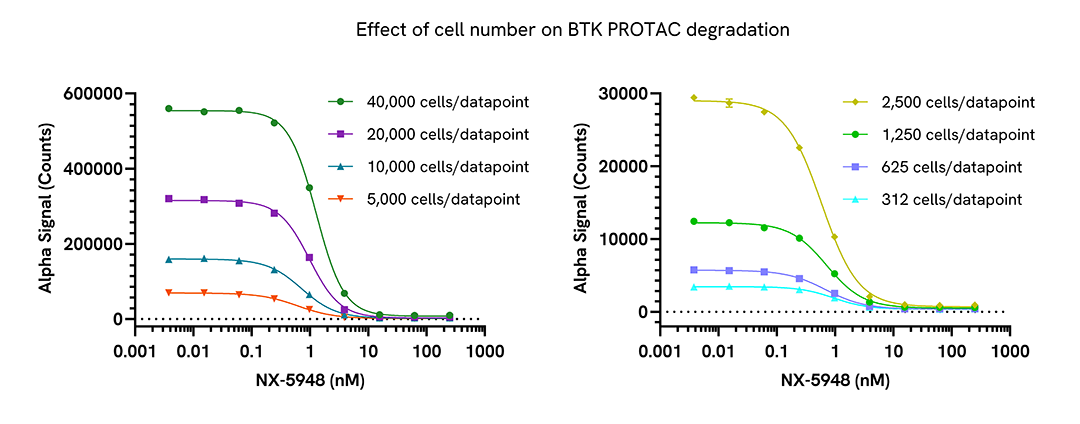
Assay versatility
Versatility of Total BTK assay in various cell lines
Adherent cells were seeded at 40,000 cells/well in a 96-well culture plate in complete medium and incubated overnight at 37°C, 5% CO2. Cells were lysed with 200 µL of Lysis Buffer.
Suspension cells were seeded at 400,000 cells/well in a 96-well culture plate and lysed with 200 µL of Lysis Buffer.
BTK levels were evaluated by AlphaLISA SureFire Ultra. For the detection step, 10 µL of cell lysate (approximately 2,000 cells (adherent) or 20,000 cells (suspension)) was transferred into a 384-well white OptiPlate, followed by 5 µL of Acceptor Mix and incubated for 1 hour at RT. Finally, 5 µL of Donor Mix was then added to each well and incubated for 1 hour at RT in the dark. The plate was read on an Envision using standard AlphaLISA settings.
As expected, BTK expression is measured only in myeloid and lymphoid cells.
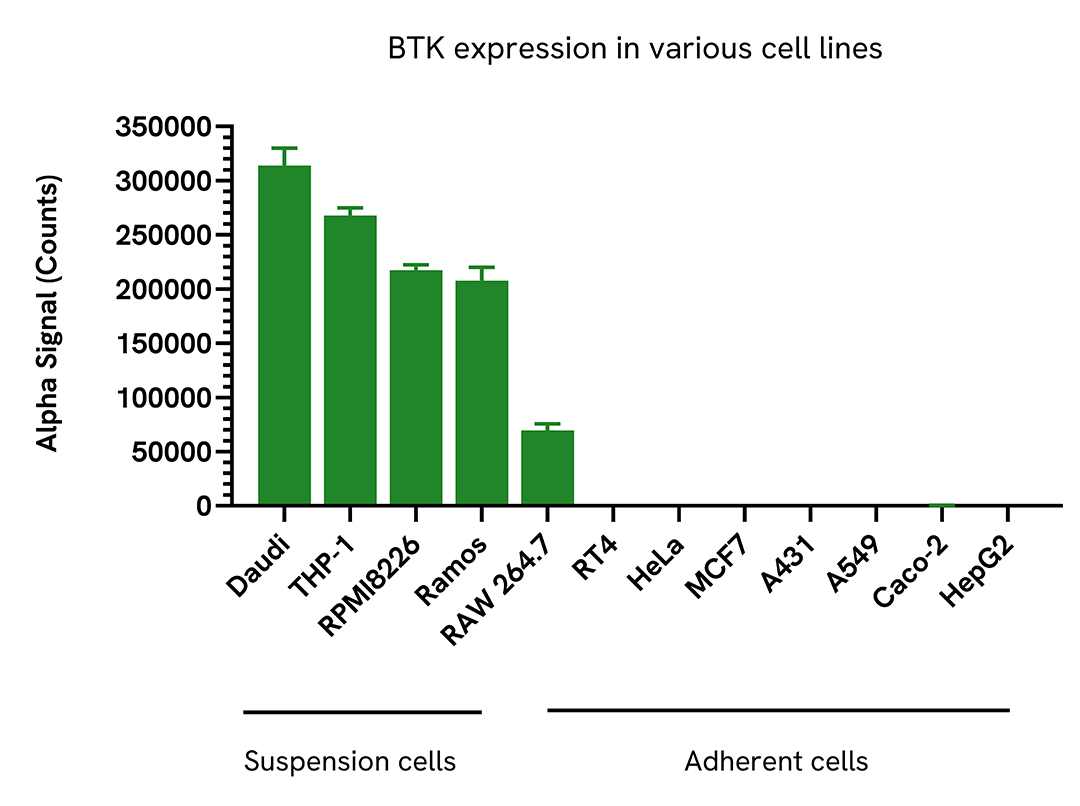
Specifications
| Application |
Cell Signaling
|
|---|---|
| Automation Compatible |
Yes
|
| Brand |
AlphaLISA SureFire Ultra
|
| Detection Modality |
Alpha
|
| Lysis Buffer Compatibility |
Lysis Buffer
|
| Molecular Modification |
Total
|
| Product Group |
Kit
|
| Sample Volume |
10 µL
|
| Shipping Conditions |
Shipped in Blue Ice
|
| Target |
BTK
|
| Target Class |
Phosphoproteins
|
| Target Species |
Human
Mouse
|
| Technology |
Alpha
|
| Unit Size |
500 assay points
|
Video gallery









Resources
Are you looking for resources, click on the resource type to explore further.
This guide outlines further possible optimization of cellular and immunoassay parameters to ensure the best possible results are...
The definitive guide for setting up a successful AlphaLISA SureFire Ultra assay
Several biological processes are regulated by...
Discover Alpha SureFire® Ultra™ assays, the no-wash cellular kinase assays leveraging Revvity's exclusive bead-based technology...
The measurement of protein phosphorylation is a useful tool for measuring the modulation of receptor activation by both antibodies...
Human fibrotic diseases are a significant health problem worldwide due to the large number of people affected and the incomplete...
This document includes detailed tables listing HTRF™, AlphaLISA™ SureFire® Ultra™, and Alpha SureFire® Ultra™ Multiplex assays...


Loading...
How can we help you?
We are here to answer your questions.
